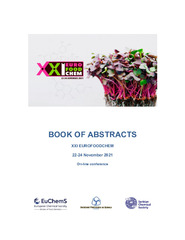Приказ основних података о документу
Extraction and quantification of tropomyosin in selected samples of shellfish
| dc.creator | Radomirović, Mirjana | |
| dc.creator | Gligorijević, Nikola | |
| dc.creator | Stanić-Vučinić, Dragana | |
| dc.creator | Rajković, Andreja | |
| dc.creator | Ćirković Veličković, Tanja | |
| dc.date.accessioned | 2024-01-04T17:02:07Z | |
| dc.date.available | 2024-01-04T17:02:07Z | |
| dc.date.issued | 2021 | |
| dc.identifier.isbn | 978-989-8124-34-0 | |
| dc.identifier.uri | https://cer.ihtm.bg.ac.rs/handle/123456789/7280 | |
| dc.description.abstract | Food allergies affect up to 10% of the general population and represent an important health problem in the field of food safety in industrialized countries. Hence, developing reliable, specific, and sensitive methods for detecting and quantifying allergens in food products is of high importance. Shellfish have been recognized as one of the eight most common sources of allergens, with tropomyosin (TPM) being considered a major heat-stable allergen, having a highly conserved amino acid sequence among different shellfish species. Allergenicity of TPM may change during food processing, such as cooking. The objective of this study was to develop an enzyme-linked immunosorbent assay (ELISA) for the detection and quantification of shellfish tropomyosin in food samples. Two different extraction buffers - phosphate-buffered saline (PBS) and PBS containing 1 M sodium-chloride (PBSN), were compared for their ability to recover proteins from pre-cooked frozen Mediterranean mussel (Mytilus galloprovincialis) and fresh frozen razor mud shrimp (Solenocera melantho). The samples were additionally cooked according to the manufacturer's instruction and analyzed as such. The protein content was quantified using Bradford protein assay, and the protein components of soluble extracts were profiled using SDS-PAGE. TPM presence was confirmed using Western blot. Sandwich ELISA was developed using a monoclonal anti-TPM antibody as a capture antibody, while polyclonal anti-TPM antibody served as a detection antibody and was coupled to the biotinylated secondary antibody and streptavidin-alkaline phosphatase conjugate. Tropomyosin was quantified using highly purified natural shrimp tropomyosin as standard. The profile of extracted proteins was changed when using PBSN instead of PBS. A higher concentration of proteins was recovered from raw shrimp using PBSN instead of PBS. At the same time, the type of extraction buffer did not affect protein recovery either from heated shrimp or pre-cooked/heated mussels. Significantly fewer proteins were extracted from cooked shrimp sample compared to the raw shrimp, while cooking showed no effect on the extraction of proteins from mussels. Cooking did not affect TPM recognition in Western blot. TPM was quantified in shrimp samples in sandwich ELISA. However, developed ELISA could not quantify mussel's TPM, indicating that this approach may distinguish mussels and shrimp TPM. | sr |
| dc.language.iso | en | sr |
| dc.publisher | Sociedade Portuguesa de Química | sr |
| dc.relation | info:eu-repo/grantAgreement/MESTD/inst-2020/200168/RS// | sr |
| dc.relation | info:eu-repo/grantAgreement/ScienceFundRS/Dijaspora/6504499/RS// | sr |
| dc.relation | info:eu-repo/grantAgreement/EC/H2020/810752/EU// | sr |
| dc.rights | openAccess | sr |
| dc.rights.uri | https://creativecommons.org/licenses/by/4.0/ | |
| dc.source | Book of Abstracts - XXI EuroFoodChem conference, 22nd-24th November, 2021, Virtual Congress | sr |
| dc.subject | food allergies | sr |
| dc.subject | tropomyosin | sr |
| dc.subject | isolation | sr |
| dc.subject | quantification | sr |
| dc.title | Extraction and quantification of tropomyosin in selected samples of shellfish | sr |
| dc.type | conferenceObject | sr |
| dc.rights.license | BY | sr |
| dc.citation.spage | 118 | |
| dc.citation.epage | 118 | |
| dc.identifier.rcub | https://hdl.handle.net/21.15107/rcub_cer_7280 | |
| dc.identifier.fulltext | http://cer.ihtm.bg.ac.rs/bitstream/id/27292/bitstream_27292.pdf | |
| dc.type.version | publishedVersion | sr |


